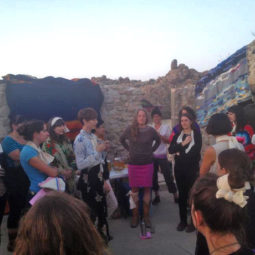
Sarah Petersen leads “Hum” with WCCW (image: Sarah Willams)
1. What led you to integrate humming into performance? Can you tell us a little about your Hums and how they evolved?
My interest in humming started with an interest in how sound acts on people subconsciously, and an interest in sympathetic vibration. I had been doing installations where I realized, in retrospect, my main interest had been in how sound acts on and pulls people through space, based on their seemingly innate curiosity about sounds whose source was invisible. But I hadn’t really done much to make manifest that interest. At a show in January 2013, at Venice 6114 in LA, I set up a humming station, with a practice amp and a mic, in a dark corner of a room, to see whether people would hum, alone or together, in public, and – if they did – to see how the vibrations produced in the room and in other listeners’ bodies would change the emotional tone of the room. People seemed to enjoy the experiment, and after that I started leading people through hums in various contexts, with the “purpose” of each hum changing based on the dynamics of each social gathering and space.
2. Your performances often engage the audience in an active role. Can you share some of your thoughts about how you approach the audience/performer relationship?
It’s a given that participatory performance can be annoying – not everyone wants to play along. At this point I try to make work that offers something to even the most reticent of passers-by, and to people who only want to be spectators. The work’s meaning and intent should be available to anyone who sees it, but the experience of actually doing the thing I’m pointing toward should offer another level of experience and meaning. I like to make room for both intellectual and embodied understanding.
3. How do you think about site in relation to your work? Specifically, how is the Baldwin Hills Scenic Overlook, the location of the upcoming SASSAS performance, influencing your process/composition?
I can’t help but consider that the hill was almost privatized, drilled and potentially fracked. I’m not sure how this will play out in the performance yet, but it’s factoring into how I consider the space as a gift, that it’s been saved. So much land hasn’t been, isn’t being protected from the proverbial jaws of capital… The Scenic Overlook has always been one of my favorite places in LA – I climbed to the top when I was visiting the day before my grad school interview with my friend Kari – we felt like we “discovered” it, and it was such an oasis for us the day before our stressful interviews. I know this place functions that way for so many Angelenos. I’ve always been a huge advocate for public parks and a frequent inhabitor/user of them. Bringing a performance into the space – an aim to be enacted with others there – is a challenge and an honor. I’m also considering the other musicians who’ll be playing on the hill that day, and how we’re all – along with the listening audience – activating and occupying and briefly colonizing the space (and I mean colonizing in a good way).
4. Can you tell us about some of the embodied practices you have studied and how they influence your work?
I was involved as a learner and occasional performer in the dance community in Minneapolis for many years – it’s such a rich community, with so many great choreographers and teachers (thanks in part to the performers brought in continuously by the Walker Art Center). Studying Body Mind Centering in the Dance Department at the University of Minnesota for two years expanded my understanding of the body and opened up innumerable channels for movement and perception. I’d taken anatomy in undergrad but this practice takes it so much further. I wish I could remember the name of the man who taught the amazing 2-hour African dance class every Saturday above Burch Pharmacy – that got me through many Minnesota winters, and it confirmed for me that joyous, sweaty, challenging bodily engagement in groups might as well be the basis for both psychotherapy and religion. I’m halfway serious. I didn’t discover Kundalini yoga til I came to LA, but its focus on breathwork and synchronizing it with bodily movement has helped focus my approach to soundmaking.
5. What other artists or musicians are you thinking about or listening to these days?
My friend Diana introduced me to Jill Purce, a British sound scholar and Tibetan humming practitioner, and her performance footage and interviews on the internet have been blowing my mind and teaching me a lot about the science of sound. I’ve also been driving around listening to Laurie Anderson’s Homeland (finally) with my friend Todd, who brought the lyrics of that album to my attention. I don’t know what took me so long – it’s so good… I listen to TV on the Radio all the time. They’re kind of my baseline. And Cat Powers’ Jukebox album. And any mixed CD that my friend Johanna makes for me – they’re always full of danceable songs I should have already known about. I like giving credit where credit is due.
5.5 Please pick a favorite or stand out clip/track from our archives and tell us why you chose it:
I feel like it has to be Pauline Oliveros’ Sonic Meditation 1: Teach Yourself to Fly, 1971, as led by Jessica Catron, Jeremy Drake, Elana Mann and Adam Overton at the Welcome Inn Time Machine in 2012! It just goes to show how many people are mining the same territory – and it’s a great warm-up for Sunday!